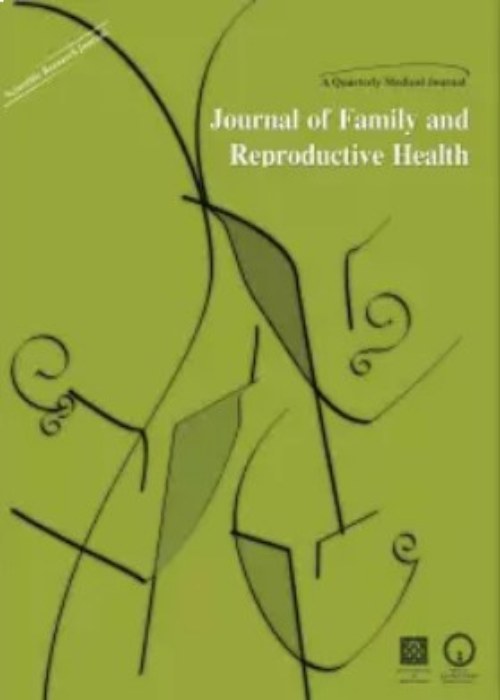فهرست مطالب
Journal of Family and Reproductive Health
Volume:5 Issue: 2, Jun 2011
- تاریخ انتشار: 1390/09/01
- تعداد عناوین: 5
-
-
Page 35Objectivewe aimed to evaluate the efficacy of celecoxib in reducing Intrathecal morphine-induced pruritus in parturient undergoing cesarean section delivery under spinal anesthesia.Materials And MethodsIn a randomized double-blind placebo controlled study 126 women undergoing elective cesarean section under spinal anesthesia (0.5% bupivacaine 12mg plus 0.2 mg preservativefree morphine)were randomly allocated to receive celecoxib 400 mg or placebo, 2 hours prior to surgery. Severity of pruritus and pain score and frequency of opioid''s side effects were recorded.Resultspatients receiving celecoxib had significantly lower pruritus incidence and severity at 30 min,2,4 and 8 hours (40% versus 82%), but not at 12 and 24 hours postoperatively. Also there was a reduction in pain score but it was not significant (1.5±0.5 versus 1.9±0.65).Analgesic requirement was similar between two groups.ConclusionOral administration of celecoxib significantly reduced Intrathecal morphine-induced pruritus in parturient undergoing cesarean section under spinal anesthesia. There was no significant difference in pain scores and analgesic requirement.
-
Page 41Assistive technologies have always opened new horizons in human''s life, posed solutions to problems and brought relief and prosperity for human beings. Iranian judicial authorities have recently recognized the importance of medical technologies. Accordingly, Iranian legal system has recognized surrogacy and a surrogacy contract seems unavoidable for surrogacy to be legally valid, socially acceptable and religiously legitimate. As a legal defense of including a typical surrogacy contract in contract law, this review studies the four building blocks of a valid contract: the intention and consent of parties, their legal capacity, the subject of the contract and its legitimacy. Discussing related Iranian Acts concerning contracts and responsibilities of parties, the authors of the present article deal with main commitments and responsibilities of the parties to a typical surrogacy contract: infertile couples, surrogate, fertility clinic or medical institute, and surrogate''s husband. The authors conclude that a surrogacy contract is accepted based on article 10 of Iranian Civil Act 1928, pose some suggestions to be included in such a contract, and emphasize that a specific Act concerning surrogacy should be approved to cover rights and legal needs of all parties to a surrogacy contract.
-
Page 53ObjectiveWe intended to determine causes and histological pattern of hysterectomies in an Iranian population.Materials And MethodsArchived reports of pathology department of a university hospital dated March 2005 to March 2009 were retrospectively reviewed. Age, chief complaint, type of operation including abdominal, vaginal and subtotal hysterectomy, the indication of the operation and the pathology of the specimen were retrieved from the records.ResultsThe average rate of hysterectomy was 219 per year. The average age of the patients was 49.6±11.3. About 40% of cases aged 45-54 years. The main chief compliant was abnormal uterine bleeding (62.2%). The leading preoperative indication for hysterectomy operations were uterine leiomyoma (24.8%) and then abnormal uterine bleeding and abdominal/pelvic mass. The most frequent pathologic findings were leiomyoma (22.0%) and adenomyosis (12.1%). In 11.8% of hysterectomy specimens no pathologic lesion was found.ConclusionThe hysterectomy is rather common in Iran with age dependent pattern of indications and corresponding pathologies.
-
Page 59ObjectiveThe aim of this study was to investigate prenatal and obstetrical outcome in mothers aged 40 years or older.Materials And MethodsA prospective comparative study was conducted for the women aged 40 years and over who delivered at 20 week''s gestation or beyond from January 2004 to December 2005 at four Hospitals of Tehran University of Medical Sciences. For comparison, a control group of patients who were 20-29 years of age was considered.ResultsThere were statistically significant increases in the rates of gestational diabetes, preeclampsia, caesarean section, breech presentation and stillbirth in women 40 years of age or older.ConclusionThere is a need to offer older women special counseling both before and after conception so that they become informed of the increased risks involved.
-
Page 65ObjectiveThe present study aimed to compare the value of ibuprofen and fennel for postpartum pain relief in women with normal vaginal delivery.Materials And MethodsIn this randomized clinical trial we studied 90 women referring to obstetrics ward for Normal Vaginal Delivery (NVD) in Assali hospital in Khoramabad. Women were randomly allocated to receive either oral ibuprofen or oral fennel by stratified random sampling technique. All women were asked to give pain score by visual analogue scale before and at 1, 2, 3 and 4 hours after treatment.ResultsDifference between fennel and ibuprofen groups was not significant considering severity of pain before (P=0.22). Difference between two groups considering mean severity of pain one hour after treatment (P=0.57) was not significant. But comparing the mean of pain severity in two groups, showed significant difference after two (p<0.023), three (p<0.001) and four (p<0.001) hours after treatment.ConclusionIbuprofen and fennel were effective for relief of postpartum pain without any notable side effects, but in general ibuprofen was more effective than fennel. More studies are needed to confirm the efficacy of fennel in pain relief especially in postpartum women which must be compared to a no treatment control group.


